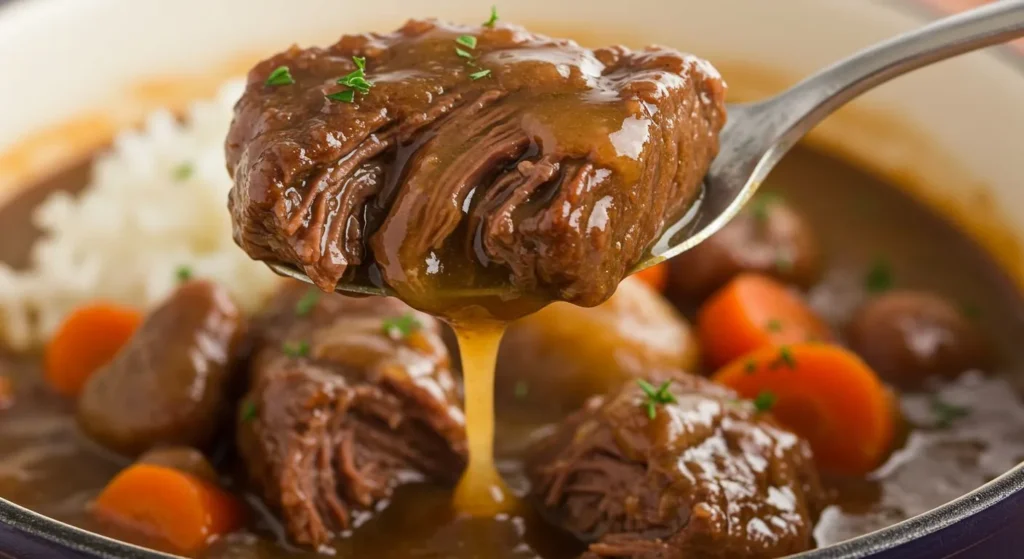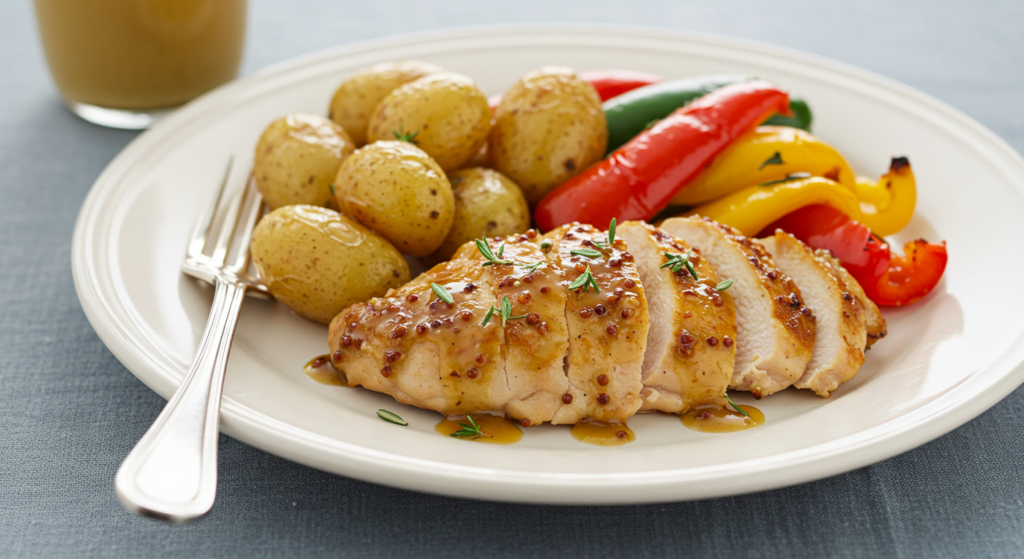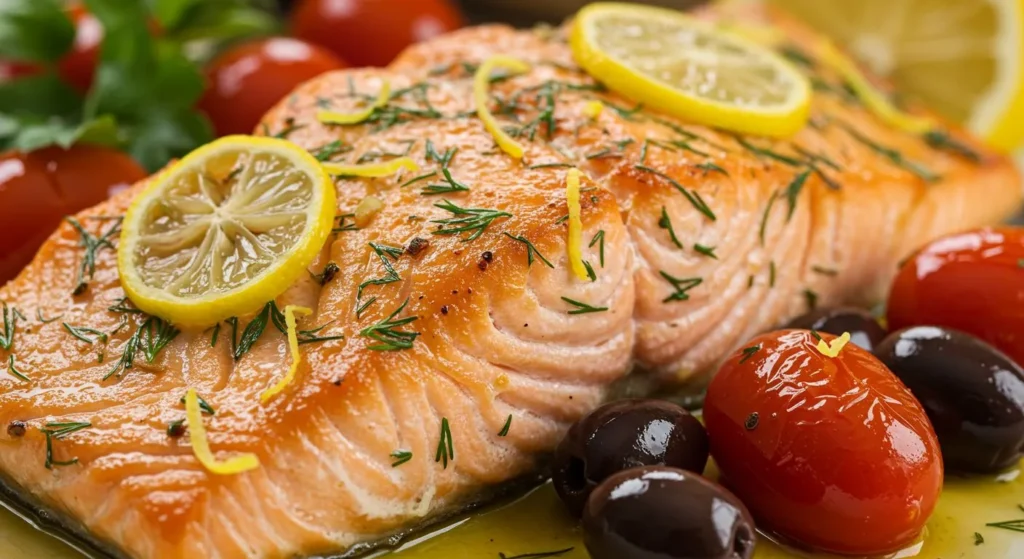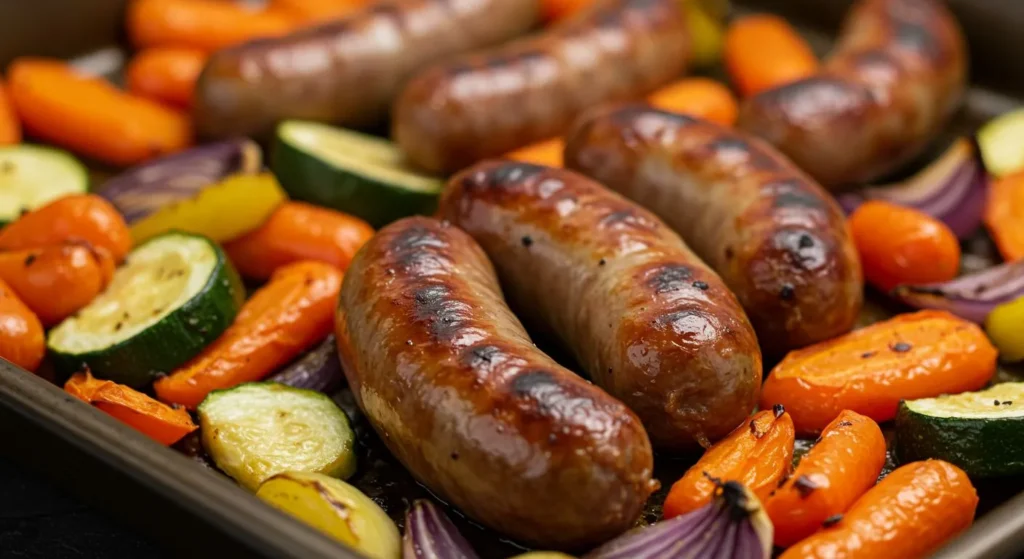
Table of Contents
That container of day-old rice sitting in your refrigerator isn’t just leftovers—it’s the foundation for one of the most versatile, satisfying meals you can create in minutes. Chicken and Vegetable Fried Rice transforms humble ingredients into a flavor-packed dish that satisfies hunger while clearing out your refrigerator. This kitchen classic combines protein, vegetables, and grains in a single skillet, offering a complete nutritional profile with minimal effort. Whether you’re cooking for a family weeknight dinner or meal prepping for busy days ahead, mastering this adaptable recipe will revolutionize how you approach leftovers forever.
Why Leftover Rice Makes the Best Fried Rice
The secret to exceptional Chicken and Vegetable Fried Rice isn’t found in exotic ingredients or complicated techniques—it’s all about starting with day-old rice. Fresh rice contains too much moisture, resulting in a soggy, clumpy finished dish. When rice cools and sits overnight, its starch structure changes in a process called retrogradation. The grains firm up, dry out slightly, and develop the perfect texture to absorb flavors while maintaining distinct, separate kernels when stir-fried.
This scientific transformation isn’t just good for texture—it also offers nutritional benefits. Cooled rice contains resistant starch, which acts more like fiber in your digestive system. This means your body absorbs fewer calories from the rice, and the resistant starch feeds beneficial gut bacteria. What begins as a practical solution for leftovers becomes a dish that’s actually healthier than using freshly cooked rice.
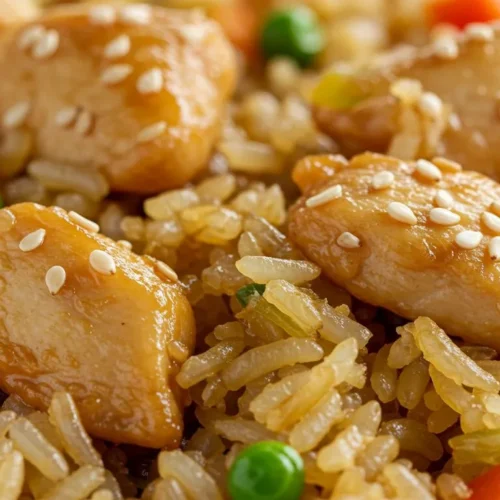
Chicken and Vegetable Fried Ric
Ingredients
- “3-4 cups cold day-old cooked rice (jasmine or long-grain)”,
- “1 lb boneless chicken cut into ½-inch cubes”,
- “3 tbsp soy sauce”
- “1 tbsp rice vinegar”
- “1 tsp sesame oil”
- “1 tbsp vegetable oil plus more as needed”,
- “1 medium onion chopped”,
- “3 cloves garlic minced”,
- “1 tbsp fresh ginger minced”,
- “1 carrot diced”,
- “½ cup frozen peas”
- “½ cup frozen corn”
- “2-3 eggs beaten”,
- “3-4 scallions sliced (white and green parts separated)”,
- “Salt and white pepper to taste”
- “Sesame seeds for garnish optional”
Essential Ingredients for Perfect Chicken and Vegetable Fried Rice
Creating restaurant-quality Chicken and Vegetable Fried Rice at home requires understanding the role each ingredient plays in building flavor and texture:
The Rice Foundation
- Cold, Leftover Rice: Ideally day-old jasmine, long-grain, or medium-grain rice. Shorter grains can become too sticky.
- Alternative Grains: Brown rice, quinoa, or cauliflower rice can substitute for traditional white rice with adjusted cooking times.
The Protein Component
- Boneless Chicken: Thighs offer more flavor and moisture tolerance, while breast meat provides a leaner option.
- Preparation: Cut into small, uniform pieces (½-inch cubes) for quick, even cooking.
- Marinade: A quick 15-minute soak in soy sauce and rice wine transforms plain chicken into a flavor-packed protein.
The Vegetable Medley
- Aromatics: Onions, garlic, and ginger form the essential flavor base.
- Colorful Standards: Carrots, peas, corn, and bell peppers add nutrition and visual appeal.
- Seasonal Additions: Almost any vegetable works—broccoli, snap peas, bean sprouts, or asparagus can be incorporated based on what’s in season or in your refrigerator.
The Flavor Builders
- Eggs: Create distinct, silky pieces throughout the dish while adding protein.
- Soy Sauce: Provides the foundational savory note and characteristic color.
- Sesame Oil: A small amount adds incredible depth and authentic aroma.
- Rice Vinegar or Shaoxing Wine: Introduces subtle acidity that balances other flavors.
- White Pepper: Offers subtle heat without the visual interruption of black pepper.
The Finishing Touches
- Scallions/Green Onions: Add fresh, bright flavor and color contrast.
- Sesame Seeds: Provide subtle crunch and visual appeal.
- Herbs: Cilantro or Thai basil can add aromatic freshness.
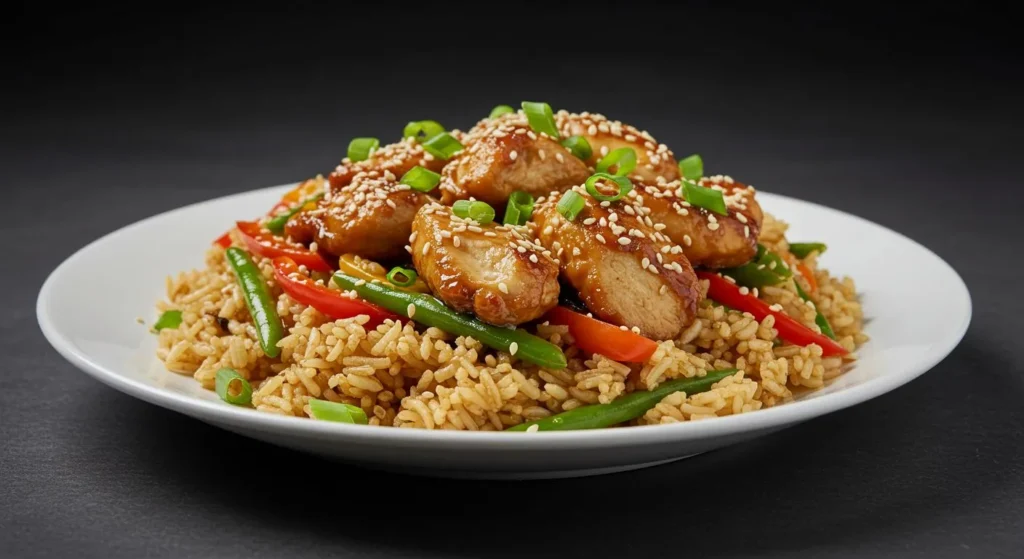
Step-by-Step Guide to Making Chicken and Vegetable Fried Rice
Creating perfect Chicken and Vegetable Fried Rice requires proper timing and technique. Follow these steps for consistently excellent results:
1. Prepare Your Ingredients
Begin by gathering and preparing all ingredients before heating your wok or skillet—this dish comes together quickly once cooking begins:
- Dice 1 pound of boneless chicken into ½-inch pieces
- Chop 1 medium onion
- Mince 3 cloves of garlic and 1 tablespoon of fresh ginger
- Dice 1 carrot into small cubes
- Gather ½ cup each of frozen peas and corn
- Slice 3-4 green onions, separating white and green parts
- Beat 2-3 eggs in a small bowl
- Break up 3-4 cups of cold, leftover rice with your fingers to separate grains
- Measure out seasonings: 3-4 tablespoons soy sauce, 1 teaspoon sesame oil, 1 tablespoon rice vinegar
2. Marinate the Chicken
In a medium bowl, combine diced chicken with 1 tablespoon soy sauce and ½ teaspoon each of salt and white pepper. Allow to marinate for at least 15 minutes while preparing other ingredients.
3. Cook the Protein
Heat 1 tablespoon of neutral oil (vegetable, canola, or peanut) in a large wok or high-sided skillet over high heat until shimmering. Add marinated chicken in a single layer and allow it to sear undisturbed for 1 minute before stirring. Cook until chicken is opaque and just cooked through, about 3-4 minutes total. Remove to a clean plate.
4. Cook the Eggs
Add another ½ tablespoon of oil to the wok. Pour in beaten eggs and let them set briefly before gently scrambling until just set but still soft, about 30 seconds. Remove to the plate with chicken.
5. Sauté the Aromatics and Vegetables
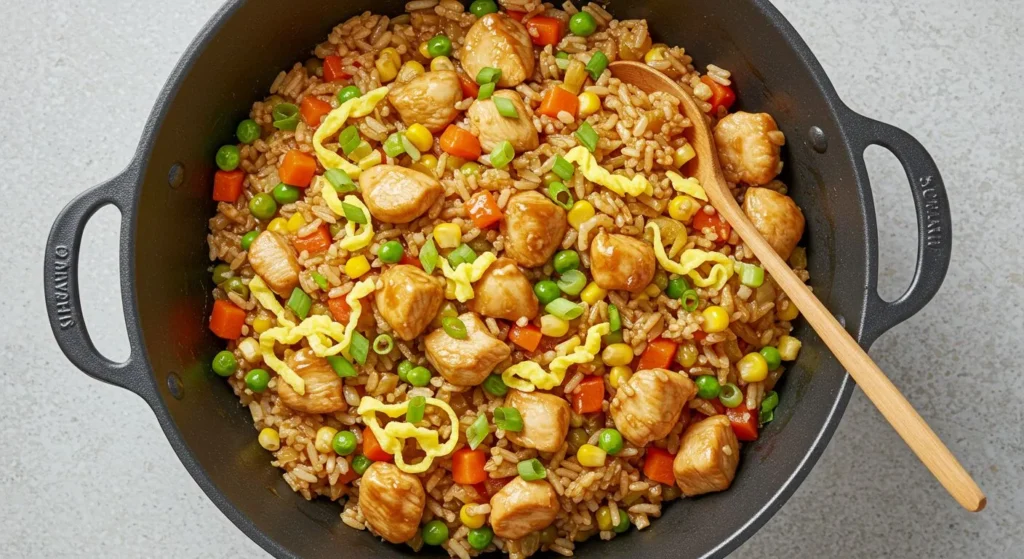
Add the remaining ½ tablespoon oil to the wok. Add white parts of green onions, diced onion, carrots, and any other firm vegetables. Stir-fry for 2 minutes until beginning to soften. Add garlic and ginger and stir-fry for 30 seconds until fragrant.
6. Add Quick-Cooking Vegetables
Toss in frozen peas and corn (no need to thaw) and any other quick-cooking vegetables. Stir-fry for 1 minute.
7. Incorporate the Rice
Add cold rice to the wok, breaking up any remaining clumps with your spatula. Stir-fry for 2-3 minutes, allowing rice to heat through and begin to crisp slightly at the edges.
8. Return Protein and Add Seasonings
Add cooked chicken and eggs back to the wok. Pour soy sauce, rice vinegar, and sesame oil around the edges of the wok so they sizzle and caramelize slightly before mixing everything together. Stir-fry for another 1-2 minutes until everything is well combined and heated through.
9. Final Seasoning and Garnish
Turn off heat and stir in green parts of scallions. Taste and adjust seasonings if needed. Sprinkle with sesame seeds if desired.
10. Serve Immediately
Transfer to a serving dish or individual bowls. Chicken and Vegetable Fried Rice is best enjoyed fresh from the wok when the textures and flavors are at their peak.
Customizing Your Chicken and Vegetable Fried Rice
The beauty of Chicken and Vegetable Fried Rice lies in its adaptability. Here are some variations to suit different dietary needs, preferences, and what you have on hand:
Protein Variations
- Shrimp: Substitute peeled, deveined shrimp for a seafood version. Add them later in the cooking process as they cook more quickly than chicken.
- Beef: Thinly sliced flank steak or sirloin works beautifully. Marinate as you would the chicken.
- Tofu: For a vegetarian option, use extra-firm tofu pressed and cubed. Pre-fry until golden before adding to the wok.
- Combination: Create a “house special” with a mix of proteins for a more elaborate version.
Vegetable Combinations
- Spring Medley: Asparagus, snow peas, and bell peppers create a fresh, seasonal variation.
- Winter Mix: Brussels sprouts, kale, and sweet potatoes offer a heartier cold-weather version.
- Asian-Inspired: Baby bok choy, water chestnuts, and bamboo shoots provide authentic texture contrasts.
- Clean-Out-The-Fridge: Almost any vegetable combination works—the key is cutting everything to similar sizes for even cooking.
Flavor Profiles
- Spicy: Add sriracha, chili oil, or minced fresh chilies for heat.
- Curry: Incorporate curry powder or paste for an Indian or Thai fusion twist.
- Korean-Inspired: Use gochujang (Korean chili paste) and kimchi for a complex, fermented flavor.
- Pineapple: Add diced pineapple for a sweet-savory balance reminiscent of Thai cuisine.
Dietary Accommodations
- Gluten-Free: Substitute tamari or coconut aminos for traditional soy sauce.
- Low-Carb: Use cauliflower rice in place of traditional rice.
- Paleo/Whole30: Combine cauliflower rice with coconut aminos and compliant oils.
- Vegan: Omit eggs and chicken, replacing with tofu, tempeh, or additional vegetables.
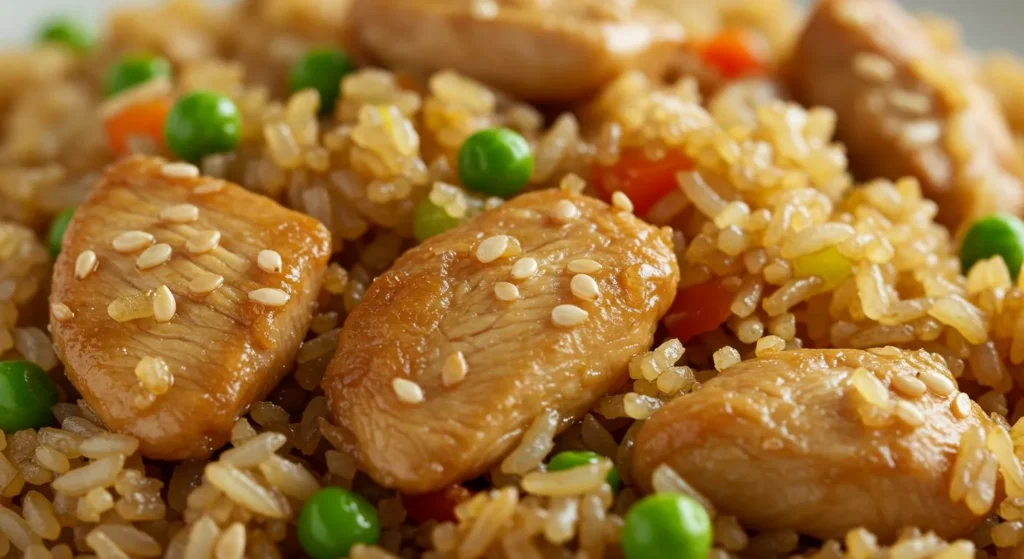
Make-Ahead and Storage Tips for Chicken and Vegetable Fried Rice
Chicken and Vegetable Fried Rice excels as both a fresh meal and as a make-ahead option. Here’s how to optimize preparation and storage:
Preparation Strategies
- Component Prep: Cook chicken, scramble eggs, and chop vegetables up to two days in advance, storing them separately in the refrigerator.
- Rice Timing: Intentionally cook extra rice for dinner, then refrigerate the leftovers to use for fried rice within 1-3 days.
- Quick Assembly: With pre-prepped components, final cooking takes less than 10 minutes.
Storage Methods
- Refrigeration: Store cooled fried rice in airtight containers in the refrigerator for up to 4 days.
- Portioning: Consider dividing into meal-sized portions for quick grab-and-go lunches.
- Freezing Options: Freeze in airtight containers for up to 3 months. Thaw overnight in the refrigerator before reheating.
Reheating Techniques
- Stovetop Revival: The best method—reheat in a wok or skillet with a small amount of oil, stirring frequently.
- Microwave Method: For convenience, microwave with a damp paper towel covering the rice to add moisture.
- Oven Option: For larger portions, reheat covered in a 350°F oven until heated through, about 15-20 minutes.
Food Safety Considerations
- Rice can harbor Bacillus cereus, a bacteria whose spores survive cooking. Always cool rice quickly and refrigerate within 1 hour of cooking.
- Never leave cooked rice at room temperature for extended periods.
- Reheat thoroughly to at least 165°F (74°C) throughout.
Nutritional Benefits of Chicken and Vegetable Fried Rice
Beyond convenience and flavor, Chicken and Vegetable Fried Rice offers impressive nutritional advantages:
Balanced Macronutrients
- Protein: Chicken and eggs provide complete proteins with all essential amino acids.
- Complex Carbohydrates: Rice delivers energy while the resistant starch in cooled rice functions partially as fiber.
- Healthy Fats: Small amounts of oil and sesame seeds offer necessary fats without excess.
Vitamin and Mineral Content
- Vitamin A: Carrots and bell peppers contribute to eye health and immune function.
- B Vitamins: Chicken and rice provide B vitamins crucial for energy metabolism.
- Vitamin C: Fresh vegetables, especially bell peppers, deliver immune-supporting vitamin C.
- Iron: Combination of heme (chicken) and non-heme (vegetables) iron supports healthy blood cells.
Fiber Sources
- Vegetables: Contribute insoluble fiber for digestive health.
- Resistant Starch: Cooled rice provides prebiotic benefits for gut bacteria.
- Optional Brown Rice: Increases fiber content significantly if substituted for white rice.
Caloric Efficiency
A typical serving (1½ cups) contains approximately:
- 350-450 calories
- 25-30g protein
- 45-50g carbohydrates
- 10-15g fat
This provides excellent satiety and energy while remaining moderate in calories.
Common Mistakes to Avoid When Making Chicken and Vegetable Fried Rice
 DINNER
DINNER  LUNCH
LUNCH  CAKE
CAKE  BREAKFAST
BREAKFAST For more amazing recipes, be sure to check out our other sections to explore a variety of ideas that will enrich your cooking experience. Each section offers its own unique flavors to ensure a delightful culinary journey:
- Easy and Quick Recipes: A collection of dishes that guarantee delicious meals with minimal effort and time.
- Healthy Recipes: Discover healthy and delicious options that fit your lifestyle.
- Desserts: A diverse selection of sweets that will add a special touch of sweetness to your table.
- Lunch Recipes: Tasty lunch ideas that you can easily prepare to delight your family.
- Dinner Recipes: Delicious and easy-to-make recipes that will make your dinner a memorable occasion.
Even experienced cooks can fall into these common pitfalls when preparing Chicken and Vegetable Fried Rice:
Using Fresh, Hot Rice
Fresh rice contains excess moisture, resulting in mushy fried rice. If you must use fresh rice, cook it with slightly less water than normal and spread it on a baking sheet to cool and dry for at least an hour before using.
Overcrowding the Wok
Adding too many ingredients at once lowers the temperature, causing steaming rather than frying. Work in batches if necessary to maintain high heat and proper texture.
Under-Seasoning
Rice absorbs significant amounts of seasoning. Don’t be shy with soy sauce, salt, and aromatics. Season in layers as you add components rather than only at the end.
Using Low Heat
Authentic fried rice requires high heat to create the proper texture and “wok hei” (breath of the wok). Your pan should be hot enough that ingredients sizzle immediately upon contact.
Overcomplicating the Dish
The beauty of fried rice lies in its simplicity. Focus on proper technique and a few quality ingredients rather than overcrowding with too many components.
Not Preparing Ingredients in Advance
Once cooking starts, this dish moves quickly. Having everything chopped, measured, and within reach before heating your wok prevents burning or overcooking.
Serving Suggestions for Chicken and Vegetable Fried Rice
While Chicken and Vegetable Fried Rice functions beautifully as a complete meal, these accompaniments can enhance the dining experience:
Simple Sides
- Miso or Egg Drop Soup: A light soup provides a warming contrast.
- Asian Cucumber Salad: The cool crunchiness balances the warm rice.
- Steamed Edamame: Adds extra protein and a fun, interactive element.
Condiment Complements
- Chili Oil or Sriracha: For those who enjoy adding heat at the table.
- Additional Soy Sauce: Allow diners to adjust saltiness to taste.
- Pickled Vegetables: Kimchi or quick-pickled carrots add tangy contrast.
Beverage Pairings
- Green Tea: The slight bitterness cleanses the palate between bites.
- Cold Beer: A light lager complements the savory flavors.
- Plum Wine: For a slightly sweet counterpoint to the umami-rich dish.
Dessert Followups
- Fresh Fruit: Pineapple, mango, or lychee provides a refreshing finish.
- Mochi Ice Cream: A small, sweet Asian-inspired treat completes the meal.
- Fortune Cookies: A fun, symbolic conclusion to your homemade Asian-inspired meal.
Frequently Asked Questions About Chicken and Vegetable Fried Rice
Can I make fried rice without leftover rice?
While day-old rice is ideal, you can simulate the effect with fresh rice: Cook with 25% less water than usual, spread on a baking sheet, and refrigerate uncovered for 30-60 minutes before using. Alternatively, cook rice normally, spread on a baking sheet, and place in the freezer for 15-20 minutes to cool rapidly and remove excess moisture.
What’s the best rice for fried rice?
Medium to long-grain varieties like jasmine or basmati work best because they maintain distinct grains after cooking. Short-grain varieties tend to be stickier and can clump together. Brown rice makes an excellent nutritious alternative but may require slightly more oil to prevent sticking.
How can I make restaurant-style fried rice at home?
Professional results come from: using very high heat (higher than most home cooks use), cooking in small batches, using a wok if possible, seasoning in layers rather than all at once, and moving quickly once cooking begins. Many restaurants also add a touch of MSG, which you can substitute with a dash of mushroom powder for similar umami enhancement.
Is fried rice healthy?
Homemade fried rice can be quite nutritious, especially when loaded with vegetables and lean protein. It offers balanced macronutrients and various micronutrients. Control oil and sodium by cooking at home, and boost nutrition by using brown rice and extra vegetables. The resistant starch in cooled rice also provides gut health benefits.
How long does leftover rice last in the refrigerator?
For food safety, use refrigerated cooked rice within 3-4 days. Rice can harbor Bacillus cereus bacteria, whose spores can survive cooking temperatures. Always cool rice quickly after cooking and refrigerate within 1-2 hours.
Can I freeze fried rice?
Yes, fried rice freezes well for up to 3 months. Cool completely before transferring to airtight containers or freezer bags. Leave some space for expansion. Thaw overnight in the refrigerator before reheating thoroughly in a skillet with a small amount of oil.
What can I substitute for soy sauce?
For gluten-free options, use tamari or liquid aminos. For lower sodium, try reduced-sodium soy sauce. Coconut aminos provide a soy-free alternative with a slightly sweeter profile. Fish sauce (used sparingly) offers different but complementary savory notes.
Why does restaurant fried rice taste different from homemade?
Restaurant differences come from: extremely high-heat commercial burners that create “wok hei” (smoky flavor), seasoned woks that impart subtle flavor, possible MSG use, higher oil content, and chef experience with precise timing. Home cooks can approximate this by using the highest heat possible and working in small batches.
Conclusion: Why Chicken and Vegetable Fried Rice Deserves a Place in Your Cooking Repertoire
Chicken and Vegetable Fried Rice represents the perfect intersection of practicality, nutrition, and culinary satisfaction. This versatile dish transforms humble leftovers into a crave-worthy meal that can be adapted endlessly to suit your family’s preferences and what you have available. By mastering this fundamental technique, you’re not just learning a recipe—you’re acquiring a cooking strategy that reduces food waste while delivering maximum flavor.
The beauty of fried rice lies in its forgiving nature and infinite adaptability. Once you understand the basic principles—cold rice, high heat, proper seasoning, and quick cooking—you can create countless variations that never grow tiresome. From simple weeknight dinners to impressive meal prep solutions, this dish offers solutions for various dining scenarios.
In a world where busy schedules often compromise nutrition, fried rice stands as a reminder that delicious, balanced meals don’t require extensive time commitments or exotic ingredients. With just a few pantry staples and refrigerator basics, you can create a dish that satisfies both the palate and nutritional needs. By transforming yesterday’s plain rice into today’s exciting meal, you’re not just cooking—you’re practicing the time-honored culinary art of making something greater than the sum of its parts.

